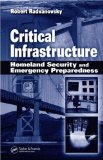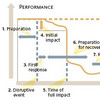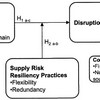 My daily morning routine includes a cup of coffee while watching the World Business Report on BBC World News. Today they had a special report on America’s crumbling and failing infrastructure. The 2005 Report Card for America’s infrastructure issued by the American Society of Civil Engineers (ASCE) leaves no doubt: It’s a D. Is America’s critical infrastructure in critical condition?
My daily morning routine includes a cup of coffee while watching the World Business Report on BBC World News. Today they had a special report on America’s crumbling and failing infrastructure. The 2005 Report Card for America’s infrastructure issued by the American Society of Civil Engineers (ASCE) leaves no doubt: It’s a D. Is America’s critical infrastructure in critical condition?
How come?
This is not some third-world country that lacks the money to put up decent roads or power transmisson lines or anything. This is one of world’s richest countries, a country equipped with both the technological know-how and the manpower necessary to stand out as an example for best practice. How can this be?
Lessons learned?
It’s just about a year now since the bridge collapse in Minneapolis, MN, where thirteen people lost their lives when the structurally deficient bridge tumbled into the Mississippi River. While the bridge has been replaced in record time, and legislation is underway to fix America’s deficient bridges, the problem appears to be far from solved, as I read in the ASCE blog.
The need for leadership and focus on infrastructure
In another post on the same blog I read that
Age, delayed maintenance, and lack of investment are what cause the physical problems of the infrastructure, but it’s the lack of compelling political leadership on the issue that has brought us to a status quo of neglect.
Much of this is true for my own country, Norway, as well. And focus has now shifted from building new roads to actually maintaining the ones that are already there, and which are becoming more and more dilapidated at an alarming rate in recent years. Do we too need a wake-up call like the Minneapolis bridge collapse? I hope not.
A way out of recession?
America’s highway and interstate system is a result of the government’s effort to overcome the big depression in the 1930s. Maybe it’s time for a new infrastructure effort, to overcome the current economic crisis? Who knows. Building better infrastructure is a good invest in the future in any case.
Related
I went to the BBC World News website hoping to find a link to a webcast of what I was watching, but maybe I was too early, or maybe they just didn’t put it up on the web. I’ll keep searching and put it up here as soon as I find it. Meanwhile, you may want to read an article I wrote some 6 years ago: The reliability and vulnerability of transportation lifelines, parts of which were cited by and incorporated into a research agenda for Critical Infrastructure Protection by the National Consortium on Remote Sensing in Transportation.
Links
- asce.org: 2005 Report Card for America’s infrastructure
- cbs.com: Nation’s Infrastructure Is Showing Its Age
- infrastructurereportcard.org: The latest – 2013 – Report card














